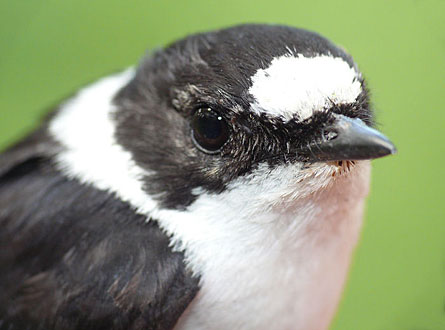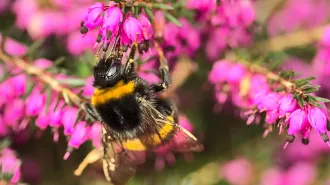Who knows whether birds have their own snarky personality jokes. But researchers now say collared flycatchers with a dashing curious character are especially likely to get caught and end up in lab studies.

These trappable birds readily explore novelties and take risks in the wild, says László Zsolt Garamszegi, now at Do±ana Biological Station near Seville, Spain. And their susceptibility indeed comes from that behavioral style, Garamszegi and his colleagues report in the April Animal Behaviour.
Much of the early work on bird “personality,” called behavioral syndrome, has tested birds in controlled settings. But Garamszegi and his colleagues watched wild birds to see if individuals’ syndromes, rather than age and condition, affected the ease of trapping.
“This is the first study in a natural bird population to study the relationship between trappability and behavioral syndromes,” Garamszegi says.
To see whether collared flycatchers (Ficedula albicollis) have behavioral syndromes, Garamszegi, then at the University of Antwerp in Belgium, and his colleagues worked with flycatchers living in nest boxes near Pilis Field Station in Hungary.
In a test for readiness to cope with novelty, researchers assessed each male’s typical behavior by placing a live female in a cage at his nest box. Then researchers attached a novel object, a piece of white paper, to the male’s nest box and watched to see how curiously he explored the oddity.
To grade birds’ willingness to take risks, researchers determined how close a bird would let them approach. And for aggressive tendencies, the researchers observed how vigorously a territory holder objected to the arrival of a caged male.
With these data, researchers found links between the behaviors in different contexts. Birds willing to explore and cope with that novel piece of paper were also likely to take more risks, letting researchers get closer.
After trying to trap the birds, the researchers linked both traits to a higher tendency to get caught. Researchers then redid their behavioral syndrome analyses, dropping data from the birds that couldn’t be caught. Losing the shy birds changed some of the results.
“Your capturing method really influences the outcome of your study,” Garamszegi says. “When you have a different sample, you may find completely different biological patterns.”
Sampling issues will differ depending on the animal, says Chad Johnson of Arizona State University in Glendale, who studies personalities in spiders. “For myself, I always wondered with fishing spiders if I was only collecting the truly lazy, unreactive spiders that did not submerge under water when they heard me coming.”
Ann Hedrick of the University of California, Davis, who studies behavioral syndromes in crickets, says the new work “draws attention to an important consideration in designing future studies.”






